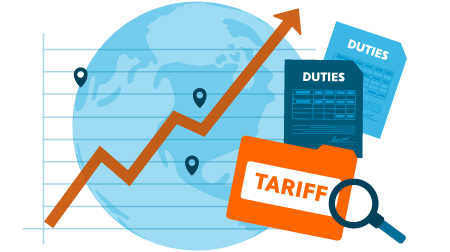
Reciprocal tariffs explained: Impact on your business
Updated on November 4, 2025, at 12:40 p.m. ET. We’re updating this blog post as new information becomes available. Avalara Cross-Border can help your business adapt to the changing dynamics of cross-border duties and tariffs. Contact us to get started.
Reciprocal tariffs originally announced on April 2 (“Liberation Day”) for a host of countries were scheduled to increase July 9, 2025. But on July 7, President Donald J. Trump delayed the effective date to August 1, 2025.
On July 31, the White House announced a modification of reciprocal tariff rates. The revised Annex I, which lists affected countries and adjusted reciprocal tariffs, includes several countries that were not on the Annex I published in early April 2025.
The new rates of duty took effect seven days from the date of the announcement, or August 7, 2025, at 12:01 a.m. ET. Since them, some rates have changed.
Key takeaways
- The temporary 10% reciprocal tariff on China will remain in effect until November 10, 2026. Other China tariffs still apply.
- The White House announced new tariff rates for dozens of countries on July 31. Countries not listed are subject to an additional ad valorem rate of duty of 10%. The new reciprocal tariffs took effect on August 7, 2025, at 12:01 a.m. ET.
- A separate announcement officially increased the tariff on Canada from 25% to 35%.
What is the meaning of reciprocal tariff?
If a tariff is a tax on goods imported from other countries, what is a reciprocal tariff?
Reciprocal means “consisting of or functioning as a return in kind” or “mutually corresponding.” So, a reciprocal tariff is a tariff on a country that matches the tariff imposed by that country. Should Country A impose a 14% tariff on Country B, Country B’s reciprocal tariff for Country A would be 14% or the equivalent.
Reciprocal tariffs are designed to combat unfair trade practices and fix trade imbalances.
What are US reciprocal tariffs in 2025?
In February 2025, President Trump announced the coming of a “Fair and Reciprocal Plan” to “counter non-reciprocal trading arrangements with trading partners by determining the equivalent of a reciprocal tariff with respect to each foreign trading partner.”
In addition to existing tariffs on U.S. goods, the plan considered such factors as value-added tax (VAT), nontariff barriers, and other practices judged to impose “any unfair limitation on market access or any structural impediment to fair competition with the market economy of the United States.”
The White House unveiled its reciprocal tariff plan on April 2, 2025, during a “Liberation Day” Rose Garden event. The plan established:
- An additional 10% ad valorem rate of duty on all imports from all trading partners starting April 5, 2025
- Higher rates of duty for trading partners listed in Annex 1, starting April 9, 2025
The baseline 10% tariff on all countries took effect as planned on April 5. However, on April 9, President Trump suspended the higher country-specific reciprocal tariffs for all nations except China, Canada, and Mexico.
The 90-day pause was to end July 9, 2025, but on July 7, President Trump delayed implementation of the country-specific reciprocal tariffs until August 1. He also started sending letters to his counterparts in other countries; the Trump tariff letters announced the rate of duty that will take effect starting August 1 but left the door open to adjusting the tariff. (See a sample tariff letter.)
On July 31, the White House published a list of modified reciprocal tariffs. The new duties take effect seven days after the date of the order, at 12:01 a.m. ET, instead of August 1.
On September 5, 2025, President Trump issued an executive order modifying the scope of reciprocal tariffs. The order exempts 39 HTS codes from the reciprocal tariffs and subjects another eight HTS codes to those tariffs. It also provides a list of HTS codes for which the president may be willing to provide a 0% reciprocal tariff rate.
Which countries are affected by US reciprocal tariffs in 2025?
President Trump imposed a 10% tariff on virtually all countries effective April 5, 2025. Canada, Mexico, and China were the only exceptions; different tariff policies apply to them. Read more about the Canada tariffs and China tariffs.
Except for the United Kingdom and the Falkland Islands, all countries will be subject to a higher rate of duty.
The tariffs announced in April and the adjusted tariffs announced July 31, which took effect on August 7, 2025, are listed below. If column one is blank, it’s because that country was not listed on the April version of Annex 1.
We’ll update this list as more adjusted rates are announced.
| Country | Reciprocal tariff announced April 2, 2025 | Adjusted reciprocal tariff that went into effect August 7, 2025 |
| Afghanistan | 15% | |
| Algeria | 30% | 30% |
| Angola | 32% | 15% |
| Bangladesh | 37% | 20% |
| Bolivia | 15% | |
| Bosnia and Herzegovina | 35% | 30% |
| Botswana | 37% | 15% |
| Brunei | 24% | 25% |
| Cambodia | 49% | 19% |
| Cameroon | 11% | 15% |
| Chad | 13% | 15% |
| Costa Rica | 15% | |
| Côte d’Ivoire | 21% | 15% |
| Democratic Republic of the Congo | 11% | 15% |
| Ecuador | 15% | |
| Equatorial Guinea | 13% | 15% |
| European Union | 20% | 0%-15% |
| Falkland Islands | 41% | 10% |
| Fiji | 32% | 15% |
| Ghana | 15% | |
| Guyana | 38% | 15% |
| Iceland | 15% | |
| India* | 26% | 25% |
| Indonesia | 32% | 19% |
| Iraq | 39% | 35% |
| Israel | 17% | 15% |
| Japan | 24% | 15% |
| Jordan | 20% | 15% |
| Kazakhstan | 27% | 25% |
| Laos | 48% | 40% |
| Lesotho | 50% | 15% |
| Libya | 31% | 30% |
| Liechtenstein | 37% | 15% |
| Madagascar | 47% | 15% |
| Malawi | 17% | 15% |
| Malaysia | 24% | 19% |
| Mauritius | 40% | 15% |
| Moldova | 31% | 25% |
| Mozambique | 16% | 15% |
| Myanmar (Burma) | 44% | 40% |
| Namibia | 21% | 15% |
| Nauru | 30% | 15% |
| New Zealand | 15% | |
| Nicaragua | 18% | 18% |
| Nigeria | 14% | 15% |
| North Macedonia | 33% | 15% |
| Norway | 15% | 15% |
| Pakistan | 29% | 19% |
| Papua New Guinea | 15% | |
| Philippines | 17% | 19% |
| Serbia | 37% | 35% |
| South Africa | 30% | 30% |
| South Korea | 25% | 15% |
| Sri Lanka | 44% | 20% |
| Switzerland | 31% | 39% |
| Syria | 41% | 41% |
| Taiwan | 32% | 20% |
| Thailand | 36% | 19% |
| Trinidad and Tobago | 15% | |
| Tunisia | 28% | 25% |
| Turkey | 15% | |
| Uganda | 15% | |
| United Kingdom | 10% | |
| Vanuatu | 22% | 15% |
| Venezuela | 15% | 15% |
| Vietnam | 46% | 20% |
| Zambia | 17% | 15% |
| Zimbabwe | 18% | 15% |
*India will be subject to an additional 25% tariff starting August 27, 2025. The extra 25% duty will stack on top of the 25% reciprocal duty listed above, as well as “any other duties, fees, taxes, exactions, and charges applicable to such imports.” However, the new 25% duty will not apply to the articles listed in Annex II of Executive Order 14257.
A 25% product currently applies to many products of Canada and Mexico. Energy and potash are subject to a 10% tariff, and products covered under the United States-Mexico-Canada Agreement (USMCA) are duty free.
Effective August 1, 2025, the 25% Canada tariff jumps to 35% according to a letter shared on Truth Social on July 10 and official guidance published July 31.
The 25% Mexico tariff was set to increase to 30% on August 1, but on July 31, Trump said the 25% rate would continue for another 90 days.
The U.S. and United Kingdom reached a trade deal in May that sets a 10% tariff on most U.K. products. More details are in this executive order and at business.gov.uk.
Brazil has been subject to the baseline 10% reciprocal tariff. On July 30, the White House announced an additional 40% tariff on Brazilian imports, for a total duty rate of 50%. Select products, such as orange juice, are exempt. See this executive order for specifics.
Tariff letters address transshipping
Transshipping is the practice of sending goods from one country to another country before shipping them to the final port of destination, or transferring cargo from one vessel to another while en route. It’s a way to sidestep tariffs imposed on the country of origin.
The Trump tariff letters specify that “goods transshipped to evade a higher tariff will be subject to that higher tariff.”
Ordinarily, this would mean the higher tariff on the country of origin would apply, rather than the lower tariff on the country the goods passed through. But that may not be what President Trump means. “Vietnam will pay the United States a 20% tariff on any and all goods sent into our territory,” he wrote on Truth Social on July 2, “and a 40% tariff on any transshipping.”
The “40% on transshipping,” Commerce Secretary Howard Lutnick later explained on X, means “if another country sells their content through products exported by Vietnam to us, they’ll get hit with a 40% tariff.”
So, there are questions about what this transshipping tariff means and how it will be enforced.
What reciprocal tariffs mean for your business
Tariffs have been in flux since February 1, when President Trump revealed his intention to impose new tariffs on China, Canada, and Mexico. New tariffs for many countries and specific products have been announced, implemented, paused, increased, and decreased, often within a matter of hours. We’ve been tracking tariff changes in this blog post.
This is a challenging environment for businesses, both for planning and compliance. When we don’t know what trade policies tomorrow will bring, it’s difficult to forecast future costs and revenue or rework supply chains.
How Avalara helps with tariff compliance
Fortunately, technology can help businesses reduce the burden of international compliance. Avalara Cross-Border automates tariff code classification, which is key to determining tariff rates, and delivers real-time calculation of customs duties and import taxes. We stay on top of regulatory changes worldwide, so our customers can focus on other aspects of their business.
To learn how Avalara can help you comply with international tax requirements, contact us today.
Reciprocal tariff FAQ
What are reciprocal tariffs?
Reciprocal tariffs are a tit for tat: They’re tariffs on imports that match the tariffs imposed by the country of export. Countries impose reciprocal tariffs to improve trade barriers and imbalances.
What’s the difference between reciprocal and retaliatory tariffs?
A reciprocal tariff matches another country’s tariff to balance trade between the two countries. A retaliatory tariff is a tax on imports from a country to punish that country for certain actions, such as setting high tariffs of its own or dumping.
What is dumping in international trade?
In trade, dumping means exporting goods to another country at a price lower than the actual cost of production or the domestic price in the country of import.

Trade and Tariff Tuesdays
Every Tuesday Avalara experts share insights on trade tax and tariff compliance
Stay up to date
Sign up for our free newsletter and stay up to date with the latest tax news.














